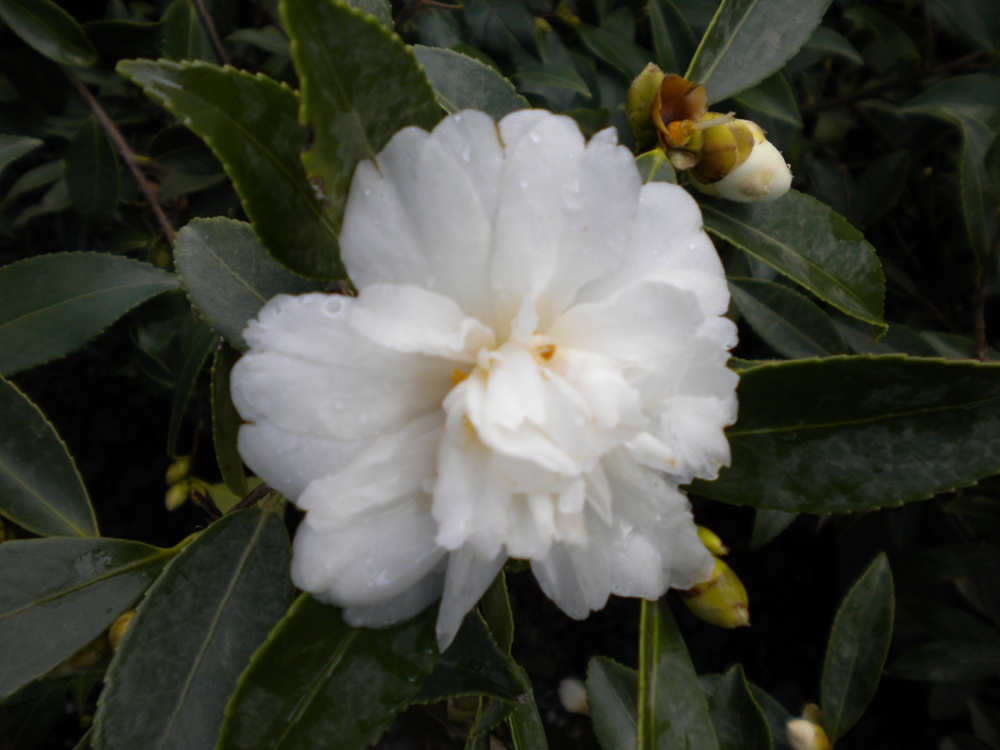I feel confident in declaring that the struggle between man and deer has been won (at least for this year, in this garden).
Five months of spraying stinky, but harmless, deer repellents has resulted in a garden undamaged, though frequently visited by deer. I still see plenty of tracks on the muddy margins of the dirt bottom pond (that’s mostly dried out), and in the damp lower lawn, but no damage to hostas, daylilies, liriopes, and the rest that they have feasted on in prior years.
 I’m convinced there’s a family, maybe a herd, living within twenty paces of the house in a swampy willow and mulberry thicket, but the repellents have worked thus far. In October, I’m not going to spray their preferred perennials again, and if the deer want to eat the frost ravaged remnants of the hostas they’re welcome to them.
I’m convinced there’s a family, maybe a herd, living within twenty paces of the house in a swampy willow and mulberry thicket, but the repellents have worked thus far. In October, I’m not going to spray their preferred perennials again, and if the deer want to eat the frost ravaged remnants of the hostas they’re welcome to them.
A colleague living in an area with more of a problem than mine has had similar success. His only slippage was a group of hostas he felt confident in planting, but didn’t get around to spraying until a couple days later. By then, it was too late.
The next challenge will be protecting evergreens through the Winter. I’m optimistic.
Also, I’m quite pleased with the Autumn garden.
Most people, and many gardeners, direct their efforts towards flowers in April and May, and sometimes into June. It seems that every tree and shrub, and most perennials, wants to bloom in Spring or early Summer. You can hardly go wrong!
Late Summer and Autumn flowers require a bit more study and perhaps more patience, but I’m thrilled with my results. If you’ve followed this journal you’ve seen that there have been blooms in this garden, and usually bunches of them, everyday since late February. Today there are less flowers than a day in May, but that’s all the more reason to appreciate those we have.
Today there are sunflowers, toad lilies (above, four buds ready to open), Japanese anemones, goldenrod, coneflowers, roses, hydrangeas, a few straggling blooms on the Franklin Tree, and the colorful red calyx of the Seven Son Tree. These have been blooming for weeks, or months, and some will continue for weeks more. A few plants are just coming into bloom.
The largest blooms in the garden today are from the Autumn Crocus or meadow saffron (Colchicum autumnale, ‘Waterlily” above), not a crocus at all, but an easy to grow perennial that blooms when dormant. The corms are toxic, like daffodils, so deer and squirrels don’t bother them. Like crocus, the flowers hover just above ground level. 
The U.S. National Arboretum has hybridized a number of Autumn flowering camellias that are quite cold hardy and floriferous (Click for more information from the Arboretum’s website). In my garden Winter’s Star (below) and Snow Flurry (above) are blooming, and will continue for a month or more. Winter’s Interlude blooms later, in early Winter, and will often save a few buds for blooming in warm spells through January. I’ve found that deer are attracted to the glossy evergreen foliage in Winter, so I’ll be careful to spray this year. 
I’ve planted both Fall and Spring blooming camellias, and am happier by far with the Autumn bloomers. The flowers are unaffected by frosts, and bloom when there are few other flowers. The late Winter, early Spring blooming camellias are more often bothered by extreme temperatures. Even though the plant isn’t killed by severe cold, flowering buds are injured.
In several weeks time fading flowers will force us to feature Autumn foliage and berries. Already the dogwoods and maples are coloring, though the berries of hollies and nandinas are still green. Beautyberry (Callicarpa americana, above) stems have been cloaked with clusters of shiny, white berries for weeks.
The more common beautyberry has glossy purple berries, both are wonderful plants. Prior to forming berries, the foliage is coarse and ordinary, and flowers numerous in August but not noteworthy. With berries, white or purple, beautyberry is stunning, a treasure that stands out in the back of the garden with tall, arching branches.
Deer do not bother it at all.